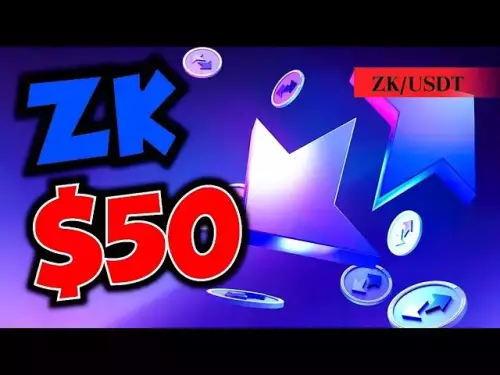 |
|
 |
|
 |
|
 |
|
 |
|
 |
|
 |
|
 |
|
 |
|
 |
|
 |
|
 |
|
 |
|
 |
|
 |
|
量子計算的快速進步對加密貨幣構成了重大威脅。該博客探討了風險,潛在解決方案以及硬幣可能在“ Q-Day”中倖存下來。

Quantum computing's relentless march forward has sparked concerns across the crypto landscape. The potential for quantum computers to crack current cryptographic standards introduces a 'Black Swan' event, threatening the very foundation of digital assets. Let's dive into the quantum threat, assess the landscape, and see who might weather the storm.
Quantum Computing的無情行進前進引發了整個加密貨幣景觀的關注。量子計算機破解當前密碼標準的潛力引入了“黑天鵝”事件,威脅著數字資產的基礎。讓我們深入研究量子威脅,評估景觀,看看誰可能會危及風暴。
The Quantum Sword of Damocles: 'Q-Day' Looms
damocles的量子劍:'q-day'迫在眉睫
The threat isn't science fiction anymore. Simulations, like those using OpenAI's ChatGPT o3 model, paint a sobering picture. A quantum breakthrough, potentially as early as 2026, could render today's cryptographic systems obsolete. This hypothetical 'Q-Day' poses an extinction-level risk to blockchains like Bitcoin and Ethereum.
威脅不再是科幻小說了。像使用OpenAi的Chatgpt O3型號的模擬一樣,繪製了一張清醒的圖片。量子突破可能早在2026年就可能使當今的加密系統過時。這個假設的“ Q-Day”對比特幣和以太坊等區塊鏈帶來了滅絕級別的風險。
At its core, blockchain security relies on asymmetric cryptography. Quantum computers, leveraging algorithms like Peter Shor’s, could potentially reverse-engineer private keys from public data, breaking the digital signatures that secure our wallets and transactions.
區塊鏈安全依賴於非對稱密碼學。量子計算機,利用Peter Shor的算法,可能會從公共數據中反向工程私鑰,從而破壞確保我們的錢包和交易的數字簽名。
Bitcoin: A Fortress Under Siege?
比特幣:圍困的要塞?
Bitcoin, with its reliance on the Elliptic Curve Digital Signature Algorithm (ECDSA), is particularly vulnerable. A significant chunk of BTC remains locked in legacy wallets without quantum-resistant protections. Estimates suggest that a substantial portion of Bitcoin holdings could be compromised post-Q-Day.
比特幣依賴橢圓曲線數字簽名算法(ECDSA)特別脆弱。大部分BTC仍然鎖定在沒有量子保護措施的情況下的傳統錢包中。估計表明,大部分比特幣持有量可能會受到Q-d日之後的損害。
Bitcoin's strength – its conservative development culture – could ironically become its weakness. The inability to adapt quickly might delay vital countermeasures, leaving it exposed in a crisis. As the o3 model puts it, Bitcoin’s survival isn’t cryptographic—it’s sociopolitical.
具有諷刺意味的是,比特幣的力量 - 其保守的發展文化 - 可能成為其弱點。無法快速適應可能會延遲重要的對策,從而使其暴露在危機中。正如O3模型所說的那樣,比特幣的生存不是密碼學,而是社會政治。
Ethereum: Agile, But Not Immune
以太坊:敏捷,但不能免疫
Ethereum, while sharing Bitcoin’s ECDSA vulnerability, boasts a more adaptable ecosystem. Its active developer community and rapid upgrade history are key assets. Ethereum has demonstrated its capacity to coordinate complex transitions, offering hope for a swift response to the quantum threat.
以太坊,在共享比特幣的ECDSA脆弱性的同時,擁有更適應性的生態系統。它的積極開發人員社區和快速升級歷史是主要資產。以太坊已經證明了其協調複雜過渡的能力,為迅速響應量子威脅提供了希望。
However, the shift to post-quantum cryptography would require extensive infrastructure overhauls. Millions of smart contracts, including those in DeFi protocols, are vulnerable to quantum decryption. While some contracts can be upgraded, vast portions of Ethereum’s contract base may be impossible to rescue without chain-wide intervention.
但是,向量子後加密的轉變將需要大量的基礎設施大修。數以百萬計的智能合約,包括Fefi協議中的合同,容易受到量子解密的影響。雖然可以升級某些合同,但如果沒有鏈條干預,以太坊合同基礎的大部分可能是不可能的。
The Quantum-Ready Few: Algorand and Beyond
量子準備的少數:Algorand及以後
Not all blockchains are created equal. Algorand emerges as a frontrunner in quantum resilience. Designed with future-proofing in mind, it incorporates cryptographic innovations like Verifiable Random Functions (VRFs) and has actively explored lattice-based encryption methods.
並非所有區塊鏈都是平等的。 Algorand成為量子彈性的領先者。它考慮了未來的衛生,它結合了諸如可驗證的隨機功能(VRF)之類的加密創新,並積極探索了基於晶格的加密方法。
Polkadot also ranks high, with its parachain architecture allowing for independent blockchains to adopt their own quantum-resilient cryptography. Other well-positioned contenders include Cosmos, Avalanche, Harmony, Tezos, Radix and Hedera.
Polkadot的排名也很高,其Parachain體系結構允許獨立區塊鏈採用自己的量子彈性加密。其他良好的競爭者包括宇宙,雪崩,和諧,Tezos,Radix和Hedera。
The Vulnerable: Privacy Coins and Meme Tokens
脆弱的:隱私硬幣和模因令牌
Privacy-focused cryptocurrencies face a particularly grim outlook. Quantum algorithms could dismantle their anonymity features, exposing past transactions. Meme coins and low-infrastructure tokens are also nearly defenseless, lacking the development teams and governance mechanisms needed to adapt.
以隱私為中心的加密貨幣面臨著特別嚴峻的看法。量子算法可以拆除其匿名功能,從而揭露過去的交易。模因硬幣和低基礎設施代幣也幾乎沒有防禦能力,缺乏適應所需的開發團隊和治理機制。
A Call to Action: Preparing for the Inevitable
行動呼籲:為不可避免的
The message is clear: strategic risk awareness is paramount. Quantum computing is not a hypothetical threat; it's an inevitable one. The crypto industry must prioritize research, improve governance, abstract cryptography, and educate communities on quantum resilience.
消息很明確:戰略風險意識至關重要。量子計算不是假設的威脅。這是不可避免的。加密貨幣行業必須優先考慮研究,改善治理,抽象的加密和教育社區有關量子彈性。
So, while the quantum future might seem daunting, remember: even Black Swans can be navigated with foresight and preparation. Maybe it's time to dust off that old quantum physics textbook, or, you know, just HODL and hope for the best. Either way, buckle up – it's going to be an interesting ride!
因此,儘管量子未來似乎令人生畏,但請記住:即使是黑天鵝也可以通過遠見和準備。也許是時候讓那本舊的量子物理教科書除塵,或者只是霍德(Hodl)並希望最好的時候。無論哪種方式,都可以搭扣 - 這將是一個有趣的旅程!
免責聲明:info@kdj.com
所提供的資訊並非交易建議。 kDJ.com對任何基於本文提供的資訊進行的投資不承擔任何責任。加密貨幣波動性較大,建議您充分研究後謹慎投資!
如果您認為本網站使用的內容侵犯了您的版權,請立即聯絡我們(info@kdj.com),我們將及時刪除。
-

-

- 比特幣、加密貨幣、以太坊:特朗普的承諾、社會情緒和機構採用
- 2025-11-06 10:41:17
- 探索比特幣、以太坊和更廣泛的加密貨幣市場的最新趨勢。從特朗普的支持到社會情緒的轉變以及瑞銀的以太坊交易。
-

-

-

-

-

- 硬幣、收益、預售:駕馭紐約的加密貨幣熱潮
- 2025-11-06 09:45:49
- 揭示“硬幣、收益、預售”的最新趨勢,重點關注 La Culex、模因硬幣和預售策略。您的模因幣混亂指南。
-

-

- 特朗普、比特幣和美國:正在形成的超級大國?
- 2025-11-06 08:20:26
- 特朗普重新關注比特幣旨在鞏固美國作為加密貨幣領導者的地位,但最近的市場波動引發了問題。





















![[4K 60fps] Morcee by DTMaster09 (1 金幣) [4K 60fps] Morcee by DTMaster09 (1 金幣)](/uploads/2025/11/06/cryptocurrencies-news/videos/690bf31847bc1_image_500_375.webp)








































